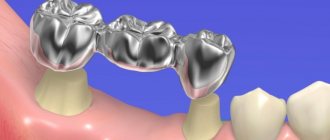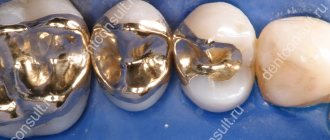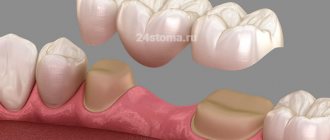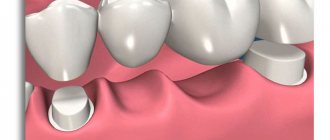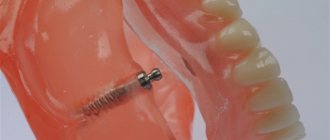Composition and application of microprosthesis
Compound
The prosthetic structure consists of a pin part that completely follows the shape of the root canal, and a stump that imitates the crown being restored. Most often, stump inlays are made from various metal alloys through precision casting. However, zirconium or aluminum oxide can also be used to produce prostheses.
Application
Standard cast pins are used to create tooth stumps with pronounced destruction of their supragingival part and the presence of healthy, strong roots. In this case, the tab is tightly fixed in the root canal so that its stump part protrudes above the gum. The stump can be used as a support for crowns, splinting structures, removable and fixed dentures.
In modern dental practice, collapsible and non-removable stump inlays are used.
Non-removable structures are used to restore teeth with one root, and collapsible ones are used to create tooth stumps with two or more roots.
Types of materials
The type of stump inlays is related to the material used to make them. Dentists use types of prosthetic models made from:
- metal;
- metal ceramics;
- solid ceramics;
- composite materials.
Metal
They come in chrome-plated cobalt and precious metals. Such models are very durable, but not always aesthetically pleasing. Therefore, they are usually made for the chewing teeth, and not for the “smile zone”.
All-ceramic
They are made from a pressed type of ceramic with the addition of zirconium dioxide. In terms of strength, this type of inlay is no worse than metal ones, but the aesthetic component is similar to porcelain structures. Their disadvantage is their fragility, which is why they are used mainly for front teeth.
Modern automated technologies are used in the manufacture of all-ceramic dental structures. Thanks to this, such prostheses are absolutely protected from factors affecting antiseptics or manufacturing technology.
When installing all-ceramic inlays, you don’t have to worry about the addition of secondary caries.
Metal-ceramic
Metal-ceramic models often fall out, as their quality is somewhat “lame”. These troubles are associated with a discrepancy between the degree of expansion of ceramics and metal.
Composite inlay
Composite products are rarely used in modern dentistry. Such designs have few advantages over ordinary fillings, but they are expensive.
There is also a special type of core prosthesis for the restoration of anterior teeth (frontally located teeth).
Inlays made of either zirconium or titanium oxide are highly durable and do not cause such a serious complication after installation as an allergy to the metal.
The gold design is ideal for the body due to the fact that it does not react with other elements and is as hypoallergenic as possible. Dentists have long loved to work with gold: it does not break down and does not corrode, but is perfectly processed (and can also be melted or forged).
Most often, gold structures are used as a reliable option for restoring chewing teeth.
On the one hand, the silver model is good for use: who doesn’t know about the bactericidal properties of this metal? However, a serious disadvantage makes it rarely used for prosthetics: a characteristic oxide film around the reconstructed tooth, followed by darkening of the enamel and pigment spots in the gum area.
Chrome-plated nickel alloy is also used for this type of prosthesis. However, experts are aware of the disadvantage of this material in the form of severe shrinkage.
Indications and contraindications for the installation of stump inlays
Indications for installation
Restoring teeth with core inlays is possible only if there is firm confidence in the reliability of the root and in the absence of any pathological processes in the periodontal tissues. The length of the root canal into which the cast post is installed must be greater than the height of the artificial crown, and the walls of the tooth must be thick enough to withstand the chewing load.
Contraindications for use
The main contraindications to prosthetics with stump inlays are:
- obstruction of the root canal or its curvature;
- pronounced changes in periodontal tissues in the absence of the ability to block the development of the pathological process;
- improper root length or tooth wall thickness;
- pathological mobility of teeth;
- incomplete filling of root canals.
Stages of manufacturing and installation of cast pins
Prosthetics with core inlays involves a number of clinical and dental measures. In particular, the main steps in the manufacture and installation of cast pins are:
- preparing a damaged tooth for installation of a stump inlay (unsealing the root canals by 2/3 of their length, preparing the tooth aimed at eliminating possible undercuts);
- taking a two-layer silicone impression from both jaws;
- covering the prepared tooth with a temporary filling (crown);
- transfer of the silicone impression to the dental department;
- making a plaster model based on the cast made;
- modeling a cast wax pin;
- casting of the prosthetic structure in the dental department;
- transfer of the finished cast pin from the dental laboratory to the dentist;
- fitting and fitting of the prosthesis;
- final installation of the core inlay and its fixation using dental cement (glass ionomer is most often used) or dual-curing composite.
- After fixing the cast pin, a suitable crown or prosthetic structure is installed on the stump.
Manufacturing principles
There are two methods of manufacturing pin stump inlays - direct and indirect. In the first case, modeling of a microprosthesis is carried out in the patient’s oral cavity. The indirect method involves making an impression of the damaged tooth, from which a core inlay is formed in the laboratory.
Direct method:
- the tooth cavity is prepared, the canals are processed, then the crown part of the tooth is formed;
- the cavity limited by the matrix is treated with Vaseline;
- modeling plastic is heated in a crucible to a fluid, but somewhat viscous state, and poured into a syringe;
- The plastic is squeezed through a wide needle into the cavity and channels to form an inlay (modeling wax can be used), before the material hardens, it is necessary to form a chewing surface by biting;
- the pin is treated with the same material, after which it is inserted into the canal;
- after the plastic has hardened, the model of the stump inlay is removed and checked for integrity (there should be no pores); if the material cannot be removed, it is drilled out and completely removed, after which the procedure is repeated;
- The dental technician uses the resulting model to make a stump inlay from the metal chosen by the patient;
- The clinic performs initial fitting, adjustment and final fixation of the microprosthesis with dental cement;
- Next, a dental crown is selected.
Indirect method:
- the tooth canals are mechanically cleaned and treated with an antiseptic, after which the crown part is formed;
- An impression is taken and sent to the laboratory;
- a technician casts a plaster model;
- a wax prototype of the inlay is created;
- wax is replaced with metal;
- the orthopedist adjusts the microprosthesis and fixes it with cement;
- The stage of selecting and creating a crown follows.
The principle of making a stump insert is the same when working with the direct and indirect method. Instead of metal, in some cases porcelain is used, but this requires taking an impression by crimping the cavity with platinum or gold foil. The porcelain inlay is attached using phosphate cement.
To determine in which cases it is necessary to use a pin stump insert instead of a structure without a pin or a simple filling, a special method for assessing tooth decay is used - IROPS.
Advantages and disadvantages of prosthetics with stump inlays
Prosthetics with cast pins, just like any other dental procedure, has a number of advantages and disadvantages.
Benefits of Tabs
The positive features of using core inlays to restore damaged teeth are:
- the possibility of completely restoring the natural shape of the replaced crown (lateral enamel ridges on its chewing surface, cusps, etc.);
- rapid normalization of the functions of the masticatory apparatus;
- monolithic structure (no risk of separation of the stump and pin);
- tight fit of the prosthesis to the root surface (minimizing wedging load).
Disadvantages of microprostheses
The main disadvantages of orthopedic dental treatment with cast pins include:
- the need for extensive preparation of the damaged tooth;
- long lead times for the manufacture and installation of a prosthetic structure (the presence of a laboratory stage, during which the pin is cast by a dental technician);
- high cost of stump inlays compared to standard pins.
Dental inlays
During life, teeth are subjected to numerous stresses and are destroyed, although enamel is the hardest tissue in the human body. Modern dentistry offers many solutions for damaged teeth. One of the solutions is special inlays to restore the functional and anatomical properties of the tooth. They can be restorative and stump. Stump inlays
serve to strengthen the tooth and are the basis on which an artificial crown is installed.
Restorative inlays
made from ceramic, zirconium dioxide and pressed ceramic can completely recreate the chewing surface of teeth. In this case, there is no need for further use of an artificial crown. All inlays are made in the laboratory and cemented in place using cement (usually glass ionomer) or a dual-curing composite (light and chemical). This method of microprosthetics allows you not only to preserve, but also to save even very damaged teeth.
What are stump inlays?
Stumps in masonry
are microprostheses that allow full restoration
the anatomical shape of the tooth and they can perform different functions, be a support for fixed and removable orthopedic structures.
This is the most effective solution for restoring damaged teeth
.
Sometimes stump inlays are called “pin” inlays, but they have nothing to do with pinning teeth. The stump tab differs from the pin
in that individual production allows you to achieve the most effective, stable and long-term result when restoring the crowns of damaged teeth.
The components of the pin inlay
are coronal and root. The crown is modeled like a ground tooth for a crown, and the root exactly copies the inside of the root canal, where it will be installed.
What materials are used.
The material from which the stumps will be made is also important.
inlays. They are usually made from a chrome-cobalt or gold-containing alloy. However, at present, stump inlays made of zirconium dioxide have become widespread.
Practice has shown that cast inlays made of metal-containing materials have better adhesion (attachment) to the canal walls than their zirconium dioxide counterparts!
Cast metal has memory, is more flexible and ductile, unlike zirconium dioxide. Stump inlays made of zirconium dioxide
are strong, but fragile, since they not only lack plasticity, but their adhesion in the tooth canal is very low.
Depending on the clinical situation, a certain type of inlay is recommended to the patient due to their design features. There is an opinion that metal core inlays will show through a zirconium dioxide crown! Zirconium dioxide, unlike pressed ceramics, is a fairly dense material and has a very low refractive index of the light flux. Therefore, crowns made of zirconium dioxide
and core inlays made of metal are an excellent compromise of price and quality for the chewing group of teeth. Such crowns will delight their owner for a long time!
Clinical and laboratory stages of manufacturing a stump inlay
For each tooth, the stump inlay (pin)
is made individually and accurately replicates
shape and features of the tooth canal.
The quality of the core inlay depends directly on the doctor’s ability to prepare the tooth canal and on the skill of the technician to make an exact copy of the tooth canal, only from metal. Failure to follow
manufacturing
plan for the core inlay
will lead to a fracture of the tooth root. The length of the root part of the cast inlay determines whether it will firmly hold the future crown, whether it will cope with the chewing load, or simply lead to a fracture of the tooth root.
IMPORTANT
: To avoid such a complication, the root part of the tab must be at least half the length of the tooth root, and also fit tightly to the canal walls and be motionless.
Only under such conditions will it be able to perform all functions: supporting and holding. The crown will be especially strong if it is attached to the stump tab.
Types of stump inlays.
The stump inlay can be made on a collapsible basis or be cast. Depending on the clinical situation, the patient is recommended to have a collapsible or non-dismountable stump
tabs
, due to their design features.
Inlays for multi-rooted teeth are made collapsible
, since the roots of the chewing teeth are not parallel.
This makes it easier to insert the tab into root canals that have different directions. In this case, the tab consists of two parts: a single-root cast tab and a cast pin. This design is fixed alternately and cannot be removed. The cast stump inlay
is a monolithic structure, which consists of one pin and a stump part.
It is used to restore a single-rooted tooth. The cost of a collapsible tab will be slightly more expensive than a simple (single-root) stump tab.
Indications and contraindications.
Stump inlays are “little helpers” that perform important work. They are indispensable for prosthetics of heavily damaged teeth, since for reliable installation of a crown in such a tooth
special fastening structures are required. Indications
for the manufacture and installation
of a pin insert:
- For severely damaged teeth (more than 70%) in the coronal part.
- To strengthen the tooth before installing a crown.
- To correct the position of teeth (in some cases).
- For front teeth and chewing teeth.
- To restore teeth after injury.
- To support a bridge prosthesis (for strengthening).
- If it is impossible to restore the crown using other methods.
- For crowns made of metal ceramics, zirconium dioxide (core inlays made of zirconium dioxide).
IMPORTANT:
Stump inlays are suitable for various types of crowns, made of
metal ceramics
,
zirconium dioxide
.
Contraindications:
- Allergies to the alloys used.
- Excessive (with periodontitis) tooth mobility.
- Perforation of the tooth root.
- Pathologies of the gums at the site where the inlay is installed.
IMPORTANT:
It makes no sense to install inlays even in the case of teeth with a questionable prognosis, in the presence of a granuloma, or a cyst.
Cost of stump inlays.
The cost of installing a stump inlay depends on factors such as a collapsible or cast model,
material used. Gold inlay price
will be significantly higher than the use of chromium-cobalt alloy and zirconium dioxide. Even the photo shows how complex this design is, so the final result largely depends on the professionalism of doctors and dental technicians. In this regard, it is natural that prices are fully influenced by the status and reputation of the clinic.
At the Danist clinic
the installation of stump inlays under the crown is carried out by specialists with extensive experience and a thorough knowledge of the technique. This approach, combined with the use of the highest quality materials and computer technology, guarantees the success of orthopedic treatment and positive feedback from patients. “Danist” is one of the best clinics in Moscow, so if the goal is to preserve an excessively damaged tooth and obtain an effective result of prosthetics, then you should come here.
